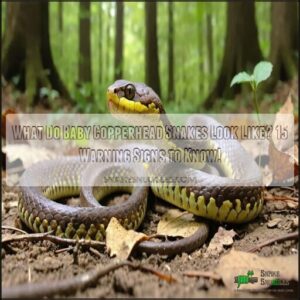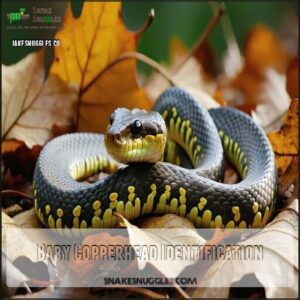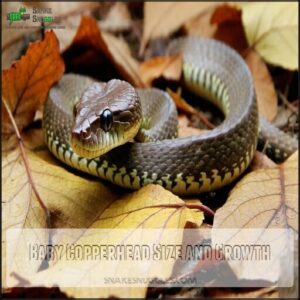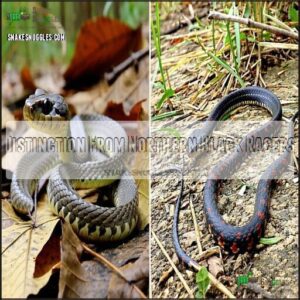This site is supported by our readers. We may earn a commission, at no cost to you, if you purchase through links.
 You’ll recognize baby copperhead snakes by their distinctive hourglass-shaped crossbands that narrow in the middle of their bodies.
You’ll recognize baby copperhead snakes by their distinctive hourglass-shaped crossbands that narrow in the middle of their bodies.
They’re born fully venomous at 7-10 inches long with copper-colored triangular heads, vertical pupils like a cat’s eye, and heat-sensing pits between their eyes and nostrils.
Their coloring ranges from pinkish-tan to light brown with chestnut or reddish-brown markings.
Unlike adults, they sport bright yellow or greenish tail tips they use as worm-like lures for prey, and despite their small size, they’re actually more likely to inject venom when they bite than their more experienced parents.
Table Of Contents
- Key Takeaways
- Baby Copperhead Identification
- What Baby Copperheads Look Like
- Baby Copperhead Size and Growth
- Distinguishing Baby Copperheads From Other Snakes
- Frequently Asked Questions (FAQs)
- What do Baby Copperheads look like?
- How do you know if a Copperhead is a baby snake?
- What do copperhead snakes look like?
- Do Baby copperhead snakes have a yellow tail?
- How big is a baby copperhead snake?
- What is the difference between a baby copperhead snake and other snakes?
- What to do if you find a baby copperhead in your yard?
- Are Baby Copperhead Snakes Active During the Day or Night?
- How Far Away Should I Be When Attempting to Remove a Baby Copperhead?
- What is the Average Lifespan of a Copperhead?
- Conclusion
Key Takeaways
- You’ll identify baby copperheads by their distinctive hourglass-shaped crossbands that narrow in the middle of their light tan to pinkish-brown bodies.
- You’ll notice their bright yellow or green tail tips, which they use as worm-like lures for prey and retain for the first 3-4 years of life.
- You’ll recognize their copper-colored triangular heads with vertical pupils (like cat’s eyes) and heat-sensing pits between their eyes and nostrils.
- You’ll need to be cautious as baby copperheads are born fully venomous at 7-10 inches long and are actually more likely to inject venom when they bite than adults.
Baby Copperhead Identification
You’ll need to identify baby copperheads by their bright yellow or green tail tips and distinctive hourglass-shaped markings on their light tan bodies.
Their triangular heads and vertical pupils are fully developed at birth, making these 7-9 inch juveniles as dangerous as their adult counterparts, with distinctive hourglass-shaped markings.
Physical Characteristics of Baby Copperheads
Five distinct features help identify baby copperhead snakes. Their pink to golden-tan bodies display dark brown hourglass-shaped bands that resemble Hershey’s Kisses when viewed from above.
Five distinct features mark baby copperheads—most notably their golden-tan bodies with dark hourglass bands resembling Hershey’s Kisses from above.
The head shape is distinctly triangular with a copper hue. Their most telling feature is the bright yellow tail tip, which they use as a clever lure for prey.
Baby copperheads are born with fully functional fangs and venom, mainly consuming insects during early development. Look for their vertical pupils and keeled scale patterns to differentiate them from non-venomous species.
They’re also known to thrive in humid forest habitats.
Distinguishing Features From Adult Copperheads
Now that you’re familiar with baby copperhead features, you’ll need to know how they differ from adults.
While both share the iconic triangular head shape, baby copperheads have four key differences:
- A bright yellow-green tail tip that adults lack
- More grayish body coloration versus adults’ coppery-brown hues
- More vibrant hourglass patterns that fade slightly with age
- Identical venomous capabilities despite their smaller size, which is a critical factor to consider when encountering them, as they possess venomous capabilities.
Comparison With Other Similar Species
While several species mimic copperhead snake markings, knowing key differences is essential for your safety.
Corn snakes display brighter red coloration and saddle-shaped patterns, unlike the copperhead’s distinctive hourglass bands.
Milk snakes have three to five rows of blotches on a slender body, contrasting with copperheads’ single row of crossbands.
Baby copperhead identification relies on their yellow tail tips, triangular heads, and heat-sensing pits.
Hognose mimicry includes puffing out necks, while water snakes lack the coppery tones that give copperheads their name.
What Baby Copperheads Look Like
Building on our identification knowledge, let’s look at what makes baby copperheads truly distinctive in the wild.
You’ll notice baby copperheads have a light tan or grayish base color marked with striking chestnut-brown hourglass patterns. These patterns are wider at the sides and narrower across the back, creating their signature appearance. Their triangular head shape houses vertical, slit-like pupils against pale gold irises.
Baby copperheads display striking hourglass patterns that widen at the sides—a signature danger sign against their light tan bodies.
The most telltale feature? A bright yellow or green tail tip that they’ll retain for their first 3-4 years—nature’s built-in prey lure. As juveniles, Eastern Rat Snakes can have similar blotched patterns, leading to misidentification.
- Their keeled scales have raised ridges, giving them a rough texture unlike smooth-scaled non-venomous species
- The hourglass pattern remains consistent from birth, though colors intensify with age
- Their copper-colored head contrasts with their body, making identification easier even from a distance
Recognizing these newborn copperhead colors and markings could save you from an unwanted encounter.
Baby Copperhead Size and Growth
You’ll find baby copperheads measuring just 7-9 inches at birth, though they grow rapidly and can double in size within their first few months.
Their growth rate depends on food availability and habitat conditions, with most reaching over 20 inches by their second year while maintaining their distinctive hourglass pattern markings.
Birth Size and Length
Newly born copperheads typically measure between 7-9 inches in length, with a distinctively lightweight build.
Despite their small size, these venomous snakelets display fully formed identifying features from birth.
The average length varies slightly within each litter, but all newborn copperhead colors include the characteristic bright yellow tail tip and brown hourglass bands against a light tan body—key elements for baby copperhead identification in the wild.
They also possess rough, keeled scales that contribute to their textured appearance.
Growth Rate and Development
Baby copperheads transform rapidly after birth, doubling their size within the first few months of life.
Their growth rate and development depend heavily on their juvenile diet and seasonal impact.
As they mature:
- Their yellow tail tip slowly darkens as they reach 3-4 years of age, marking sexual maturity
- Their venom potency increases as venom glands develop fully
- Their distinctive hourglass pattern remains consistent while scale development continues
Lifespan factors like predation mean fewer than 20% survive their first year in the wild.
Factors Affecting Size and Growth
Five key factors dramatically influence baby copperhead growth rates and ultimate size.
Genetic influence establishes their growth potential, with offspring inheriting size tendencies from parents.
Habitat quality plays a vital role—snakes in resource-rich environments develop faster than those in harsh conditions.
Food availability directly impacts development; consistent access to prey accelerates growth while scarcity stunts it.
Seasonal changes affect feeding patterns, with growth typically slowing during winter months.
Environmental stressors like extreme temperatures or predator presence can redirect energy from growth to survival.
Age factors are particularly significant—you’ll notice baby copperheads grow rapidly in their first year, with development slowing as they mature.
Snake development follows predictable patterns when these factors remain consistent.
The factors mentioned are key to understanding the growth of baby copperheads, and how they are influenced by their environment.
These elements, including genetic influence and habitat quality, all play a role in the growth rates of these snakes.
Distinguishing Baby Copperheads From Other Snakes
You’ll need to examine specific features like hourglass patterns, yellow-green tail tips, and triangular heads to correctly identify baby copperheads among lookalike species.
Baby rat snakes, eastern hognose snakes, and northern black racers can all resemble young copperheads at first glance, but they lack the combination of distinctive traits that make copperheads immediately dangerous.
Comparison With Baby Rat Snakes
Anyone can distinguish baby copperheads from juvenile eastern ratsnakes with these key differences:
- The copperhead’s distinctive hourglass markings versus ratsnake’s irregular blotches
- Copperhead’s triangular head compared to ratsnake’s more oval shape
- Ratsnake’s smooth scales contrast with copperhead’s rough, keeled scales
- Copperheads possess the telltale bright yellow/green tail tip
- Ratsnakes tend to climb and explore, while copperheads remain primarily ground-dwelling
Ratsnakes are harmless, but copperheads are venomous—so accurate identification through snake comparison is essential for your safety.
Juvenile copperheads utilize their bright tail as lure for prey.
Differences From Eastern Hognose Snakes
Eastern hognose snakes often trip up even experienced snake spotters due to their copperhead-like coloration.
While these copperhead lookalikes display defensive mimicry, they lack venom and possess distinctly different features.
How to tell them apart:
- Head Shape: Hognoses have upturned snouts, while baby copperheads display triangular heads with heat-sensing pits
- Scale Texture: Hognoses have strongly keeled scales compared to copperhead offspring markings
- Color Variations: Hognoses show blotchy patterns rather than the distinct hourglass bands of copperheads
Distinction From Northern Black Racers
While Eastern Hognose snakes mimic copperheads with their body patterns, Northern Black Racers present different identification challenges.
You’ll notice Head Shape differences immediately—racers have slender heads while baby copperheads display triangular shapes.
Color Comparison reveals juvenile racers are gray with reddish-brown blotches, contrasting with copperhead snake markings featuring distinct hourglass bands.
Behavior Differences are striking too: racers flee when approached, while copperheads remain still, relying on camouflage.
Scale Texture offers another clue—racers have smooth scales versus the keeled (ridged) scales of copperheads.
In Habitat Overlap areas, remember: racers are alert and active, while baby copperhead identification often starts with their stillness.
Frequently Asked Questions (FAQs)
What do Baby Copperheads look like?
Like copper pennies glinting in the sun, baby copperheads have bright yellow-green tail tips, hourglass-shaped patterns on their 7-9 inch bodies, spade-shaped heads, and vertical pupils.
You’ll notice they’re born with fully functional venom.
How do you know if a Copperhead is a baby snake?
Baby copperheads have bright yellow or green tail tips, are 7-9 inches long, and display the same distinctive hourglass pattern as adults, but with more vibrant coloration.
They’ll have triangular heads and vertical pupils.
What do copperhead snakes look like?
Copperhead snakes display triangular heads, copper-colored tops, and distinctive hourglass patterns on their reddish-brown bodies.
You’ll notice their vertical pupils, heat-sensing pits between eyes and nostrils, and thick, short bodies compared to non-venomous species, which can help identify them by their distinctive hourglass patterns.
Do Baby copperhead snakes have a yellow tail?
As nature’s warning flag, the distinctive yellow tail tip adorns baby copperheads until they’re about 3-4 years old. You’ll notice this bright lure gradually darkens with age as they mature.
How big is a baby copperhead snake?
When born, you’ll find these venomous youngsters typically measuring 7-9 inches long.
They’re lightweight with fully functional venom and grow rapidly, potentially doubling their size within their first few months of life, which is a rapid growth.
What is the difference between a baby copperhead snake and other snakes?
No snake in the grass here – you’ll spot baby copperheads by their bright yellow/green tail tips, hourglass-shaped markings, triangular heads, and vertical pupils.
They’re shorter and thicker than non-venomous species, which can be an important distinction to make when identifying them.
What to do if you find a baby copperhead in your yard?
Remain calm and don’t touch it. Keep children and pets away. Call a professional snake removal service immediately. While waiting, observe from a safe distance to help identify it accurately.
Are Baby Copperhead Snakes Active During the Day or Night?
You’ll find baby copperheads active during both day and night.
They’re typically diurnal in spring and fall, but shift to nocturnal behavior during summer’s heat.
They prefer warm, humid nights after rainfall for hunting.
How Far Away Should I Be When Attempting to Remove a Baby Copperhead?
You should never attempt to remove a baby copperhead yourself. Stay at least 10-15 feet away and call wildlife professionals who’ve proper equipment and training for safe removal.
What is the Average Lifespan of a Copperhead?
While they might seem eternal when you’re encountering one, you’ll find copperheads typically survive 6-8 years in wild conditions.
But can live up to 18 years naturally and reach 25 years in captivity.
Conclusion
Like venomous jewels of nature’s warning system, baby copperhead snakes demand your respect and caution.
Remember, these young serpents display distinctive hourglass-shaped bands, copper-colored triangular heads, and yellowish tail tips.
You’ll recognize what baby copperhead snakes look like by their vertical pupils and heat-sensing pits. Though small, they’re fully equipped with venom from birth and more likely to inject it than adults.
When in doubt, maintain a safe distance and call wildlife professionals.
- https://www.uta.edu/biology/herpetology/copperheads.htm
- https://www.snakebitefoundation.org/blog/2018/8/23/are-baby-rattlesnakes-really-more-dangerous-than-adults-5sh6p
- https://scholarlycommons.henryford.com/cgi/viewcontent.cgi?article=1231&context=emergencymedicine_articles
- https://journals.biologists.com/jeb/article/207/24/4231/2678/Heat-in-evolution-s-kitchen-evolutionary











